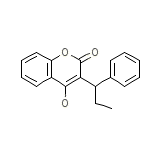Falithrom




Categoria
Falithrom Nombres de marca, Falithrom Analogos
Falithrom Marca los nombres de mezcla
Falithrom Formula quimica
C18H16O3
Falithrom RX enlace
No information avaliable
Falithrom FDA hoja
Falithrom MSDS (hoja de seguridad de materiales)
Falithrom Sintesis de referencia
No hay información disponible
Falithrom Peso molecular
280.318 g/mol
Falithrom Punto de fusion
179.5 oC
Falithrom H2O Solubilidad
12.9 mg / L
Falithrom Estado
Solid
Falithrom LogP
4.59
Falithrom Formas de dosificacion
Tableta
Falithrom Indicacion
Se utiliza para la prevención y el tratamiento de la enfermedad tromboembólica incluyendo la trombosis venosa, tromboembolismo y embolia pulmonar, así como para la prevención del ictus isquémico en pacientes con fibrilación auricular (FA).
Falithrom Farmacologia
Fenprocumon, un anticoagulante cumarínico, adelgaza la sangre al antagonista de la vitamina K que se requiere para la producción de factores de coagulación en el hígado. Anticoagulantes como fenprocumon no tienen directa efecto sobre un trombo establecido, ni revertir el daño del tejido isquémico (daños causados por un inadecuado suministro de sangre a un órgano o parte del cuerpo). Sin embargo, una vez que se ha producido un trombo, el objetivo del tratamiento anticoagulante es prevenir la ampliación de la formación del coágulo y prevenir las complicaciones tromboembólicas secundarias que pueden dar lugar a secuelas graves y posiblemente fatales.
Falithrom Absorcion
La biodisponibilidad es cercana al 100%
Falithrom Toxicidad
50 = 500 mg / kg. Los síntomas de sobredosis incluyen sangrado anormal o sospechoso manifiesta (por ejemplo, la aparición de sangre en las heces o la orina, hematuria, sangrado menstrual excesivo, melena, petequias, moretones en exceso o persistente, supuración de heridas superficiales).
Falithrom Informacion de Pacientes
The objective of anticoagulant therapy is to decrease the clotting ability of the blood so that thrombosis is prevented, while avoiding spontaneous bleeding. Effective therapeutic levels with minimal complications are in part dependent upon cooperative and well-instructed patients who communicate effectively with their physician. Patients should be advised: Strict adherence to prescribed dosage schedule is necessary. Do not take or discontinue any other medication, including salicylates (e.g., aspirin and topical analgesics), other over-the-counter medications, and botanical (herbal) products (e.g., bromelains, coenzyme Q10, danshen, dong quai, garlic, Ginkgo biloba, ginseng, and St. John's wort) except on advice of the physician. Avoid alcohol consumption. Do not take phenprocoumon during pregnancy and do not become pregnant while taking it. Avoid any activity or sport that may result in traumatic injury. Prothrombin time tests and regular visits to physician or clinic are needed to monitor therapy. Carry identification stating that phenprocoumon is being taken. If the prescribed dose of phenprocoumon is forgotten, notify the physician immediately. Take the dose as soon as possible on the same day but do not take a double dose of phenprocoumon the next day to make up for missed doses. The amount of vitamin K in food may affect therapy with phenprocoumon. Eat a normal, balanced diet maintaining a consistent amount of vitamin K. Avoid drastic changes in dietary habits, such as eating large amounts of green leafy vegetables. Contact physician to report any illness, such as diarrhea, infection or fever. Notify physician immediately if any unusual bleeding or symptoms occur. Signs and symptoms of bleeding include: pain, swelling or discomfort, prolonged bleeding from cuts, increased menstrual flow or vaginal bleeding, nosebleeds, bleeding of gums from brushing, unusual bleeding or bruising, red or dark brown urine, red or tar black stools, headache, dizziness, or weakness. If therapy with phenprocoumon is discontinued, patients should be cautioned that the anticoagulant effects of phenprocoumon may persist for about 2 to 5 days.
Falithrom Organismos afectados
Humanos y otros mamíferos














